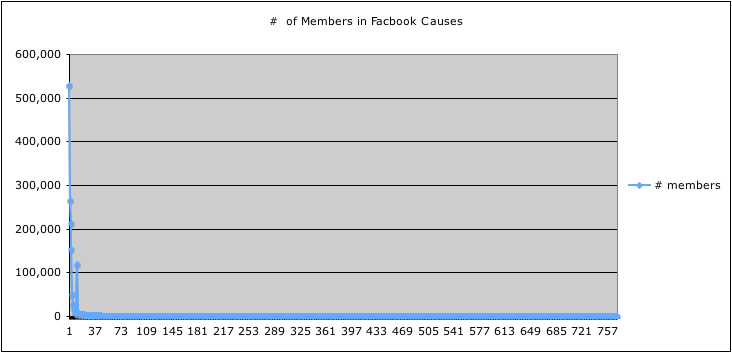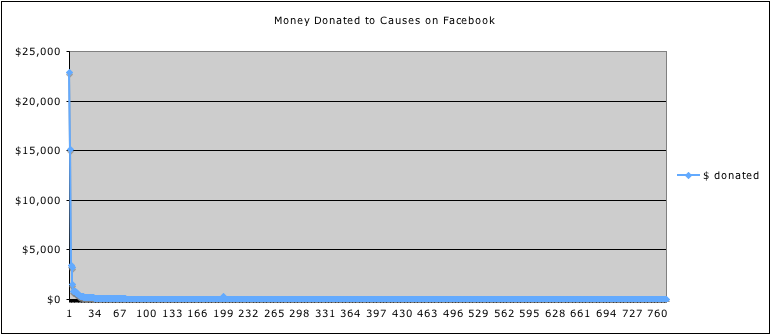
Post co-authored by James O'Malley and Justin Perkins.
If you've missed the launch of Facebook Apps Platform almost two months ago, you're already way behind the times. The technology "enables anyone to build any application that...Facebook could build." The result has been innumerable neat applications that allow you to give free gifts to your friends, watch videos on Facebook, and even manage an imaginary stock portfolio. A couple of Care2 staff favorites, of course, include the Care2 Stickies and Petitions.
The very cool Causes application by Project Agape enables anyone with a Facebook account to support and engage their Facebook networks to support a "Cause" - be it "Save the Seals!," "End Global Warming!," or "Fight Hate." All of the Causes have to be attached to a Guidestar-verified 501(c)(3).
The developers hope to revolutionize the way people give money, using the principles of group fundraising and social networking. (For a good overview of other group fundraising (or micro-philanthropy), check out Peter Deitz's writing about the benchmarks and tools). While the Causes idea smartly takes advantage of an existing platform with a huge audience, a deeper dive into the data is revealing.
The following riffs can help you determine whether or not the Causes application is a worthwhile endeavor for your nonprofit. That said, you may have no choice in the matter if you're already listed on Guidestar -- some benevolent, or mischevious, Facebook member may be promoting your nonprofit already.
The Data
What kind of results are people seeing to date?
We took a sampling from all of the Causes to get a sense of what the potential is. There are currently about 8,000 Causes, and we sampled about 10% of them. Lots of zero dollar donations in that sample (555 out of the 774 we sampled). Of the 218 causes that actually had donations, the average money earned was about $290, and the average number of supporters was about 6,600 (that was after throwing out all of the zeros). That works out to an average of about $1.24 per supporter. The total donations ran from $5 to $22,871. Here is a graph of the results. It's a pretty long tail. If you're a spreadsheet junkie, you can see the data set here.
Perhaps more relevant than the average in this case, however, are the median (36 for Cause members, $0 for donations or $30 if you throw out all the instances of zero donations) and the mode (6 for members and $0 for donations -- $10 if you throw out the 555 instances of zero). Translation: you're more likely to get between $0 and $30 per Cause -- not the average of $290.

Tips for Promoting a Cause on Facebook
If you build it, will they come?
Don’t plan on reaching your fundraising goals within hours of launching your social networking campaign, unless you have the largest Facebook network of friends ever. Without a "knock-em-dead" sort of Cause that will go viral instantly, which is pretty rare, it'll take time for your Cause to gain popularity, if it ever does.
It's all about the Causes' Champion and network
Since Causes are started by users, the success of a Cause is highly dependent upon the user who began it. That said, even if you are the resident marketing guru, your number of Facebook friends is far more important than your number of years of experience. When it comes to recruiting members, a high schooler with 500 friends can easily outclass a marketing wiz who's a Facebook newbie.
Mobilize your current assets
Credit to the Beaconfire Wire for this one. The worst thing to do is to keep your Cause in a vaccuum. Make sure that the supporters who are already interested in your nonprofit (evidenced by their visiting your website!) know about your Cause. Advertise it on your website as a cool, new way for people to donate and assist your organization. As with any social network campaign, it's not a bad idea to ask your existing supporters to help you spread the word on Facebook for you. You may also be able to identify a segment of your audience that can help you with urgent campaigns in the future in which you might want to reach the Facebook audience.
Read this post from Wild Apricot
This post provides a pretty basic, easy, 5-step process to get you started creating and promoting your Cause.
Flaws in the Causes Application
It’s ahead of its time
Regardless of the fact that Facebook is now open to everyone, the majority of active users are still under the age of 24. Maybe that's OK if you can get 250,000 twenty-somethings to donate a $1 or $2. Crowd-sourcing. The problem is that the same challenges apply in any medium -- you need to cut through the noise, develop a list of supporters, get those supporters to pay attention, and encourage those supporters to do something. According to Network for Good, friends are better at doing that than organizations are, when it comes to soliciting donations.
While the exact demographic numbers are somewhat disputed, without a doubt the typical user is a young student. As has been seen time and time again, the best donors are well over the age of 30 - the people LEAST likely to be on Facebook, nevermind using the Causes application!
For now, Causes is not going to be the anwer to fundraisers' prayers for an easy well to tap for money. As you can see from the data, some will get lucky. Those who do will have a great excuse for a PR moment, and that, in turn, can feed back into their success, as well.
Too many “fluff” Causes
As of July 16th, there were 7,575 Causes within the application. Having at least scanned nearly all of them, it's reasonable to say that only about 60% are legitimate. That leaves about 3,000 "fluff" Causes - i.e. causes for which the chief intended purpose was not social change, but rather (most likely), humor, slander or annoyance. With that many fake Causes floating around, the real ones get lost before they even gain momentum. For example, if the Causes channel's "Political Campaign" section were the real primaries, then the results would be:
- Barack Obama
- Duncan Hunter
- Hillary Clinton
- Stephen Colbert
Colbert's Cause has raised more money than Hunter's.
Also keep an eye out for "Who gives a S**T about Paris Hilton !!!," "Save Water, Drink Beer," and "Save the Oompa Loompas" which all appear on the front page of their respective categories as well. While they may be attached to real nonprofits, they drown out many smaller, legitimate Causes.
The verification process needs some work
By far, the most popular “Guidestar-certified” nonprofit on the Causes application is Just Say No, the movement started by Nancy Reagan as an anti-drug campaign. According to Guidestar, the organization currently has $1 of Assets and $1 Income. A quick Google search shows that the man listed as the primary contact for the organization is dead. Just Say No’s listed phone number is now someone’s personal cell phone, and the web site provided is now a junk site linking you to 4.65% home equity loans.
While Just Say No is for all intents and purposes dead, wouldn't it be a shame if "No homosexuals in Canada and the world" was connected to your GLBT rights organization? Or "Nuke the whales" to your animal rights group? Fortunately, according to Randall Winston from Project Agape, "Nonprofits can indeed disassociate themselves from a Cause whenever
they like. An email is sent to the nonprofit every time a Cause is created that benefits them, and they can then view the cause and contact our nonprofit support team if they'd like to disassociate their organization." So far, it doesn't seem that nonprofits do a very good job of policing Causes, which, to be fair, is not the application's fault.
Your supporters can get split up
The point of group fundraising tools is to tap into individuals' existing networks. However, this can also lead to confusion in a closed network. The World Wildlife Fund (WWF), a nonprofit with a good reputation, has 47 different Causes contributing towards it. To date, the largest one has 40,406 members and has raised $1,777 for the organization. Not bad. But what would happen if all of those 47 Causes consolidated into one, huge Cause? The additional members could potentially bump up the rank, making it one of the biggest Causes in the application. This would lead to even more people joining the Cause and potentially donating even more money. Perhaps this would be even better for the organization in the long run. That said, the long tail of the internet (in this case, social networks as a microcosm of the internet) comes into play, and having a consolidated mega-group might kill the inspiration of the individuals who are raising money, in their own voice, for you.
One way to work around this problem -- and some of the smaller nonprofits have done this -- is to have an employee post on the wall of all the groups to direct people to an "official" Cause. Clearly, one Cause with 100 members will be more successful at raising funds than 20 Causes with five members.
Conclusion:
To be fair, the Causes App is only two months old, so it will be interesting to see how much money organizations raise over time, and how the behavior of Facebook users will play out. For now, as much as there is potential for "free" money, social networks -- and the apps that go with them -- are not a silver bullet, yet. The same old organizing rules still seem to apply, though there are some obvious advantages to playing in social networks if you are promoting a nonprofit cause. Social networks are different from other mediums, in that they tap into some basic human needs in a new way -- the need to be part of a group, the need to be creative, and the need to have a voice heard in a public forum. But it's tough to get in the middle of that, as an organization. It can take a lot of time.
So for now, we'll remind you to think like a rock band if you want to spend your time in these mediums. And you should be everywhere, but prioritize. And if you have a case study, or some interesting results or insights, post 'em here in the comments.
For a straightforward look into some metrics that indicate whether social networks can benefit your nonprofit, check out the frogloop Social Network ROI Calculator.



COMMENTS